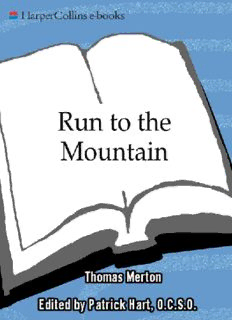
Run to the Mountain: The Story of a Vocation (The Journal of Thomas Merton, Volume 1: 1939-1941) PDF
Preview Run to the Mountain: The Story of a Vocation (The Journal of Thomas Merton, Volume 1: 1939-1941)
Thomas Merton Run to the Mountain The Story of a Vocation EDITED BY PATRICK HART, O.C.S.O. Run to the mountain; Shed those scales on your eyes That hinder you from seeing God. DANTE, Purgatorio, II, 7 Contents Epigraph v Preface xi Acknowledgments xiii Introduction xv PART I: Perry Street, New York May 1939–February 1940 1 PART II: Cuban Interlude February 1940–May 1940 151 PART III: Saint Bonaventure’s, New York June 1940–December 1941 229 Appendix to the paperback edition 473 Index 485 About the Author Cover Copyright About the Publisher Preface Thomas Merton occasionally wrote of keeping a journal in his youth, and how wonderful it was to reread entries at a later date, tearing them out and discarding them. Unfortunately, Merton must have destroyed not a few journals of the pre- monastic years, because the earliest we have are from 1939 to 1941, just before he entered the Abbey of Gethsemani. Sporadically, as a young monk, Merton kept a journal, but only a few fragments of the novitiate journal remains. The most sus- tained journal writing was done during the rest of his monastic life, from the Sign of Jonas period until The Asian Journal. But even then we find some gaps, long periods when time prevented him from keeping a regular journal and even (unfortunately) some missing pages. When in 1990 the Trustees of the Merton Legacy Trust asked me to be general editor of the Merton journals, the first thing I did was visit St. Bonaventure’s and have copies made of these early journals. It has taken several years of research to determine the amount of journal material that was available. Once I had gone through the various collections–especially the monastic journals (written for the most part at Gethsemani and now housed at the Thomas Merton Center of Bel- larmine College, Louisville), as well as the fragment from Merton’s novitiate days, and three other journals from 1947 to 1951 (which are now a part of Columbia University Library’s Special Collections), and St. Bonaventure University’s Merton archives–it was decided to have seven volumes of Merton journals. The Merton Legacy Trust, which was drawn up the year before Merton’s death, includes the indenture that the journals may be published “in whole or in part” at the discretion of the Merton Legacy Trust, but not until after the official biography had been published and twenty-five years had elapsed since his death. The author- ized biography, The Seven Mountains of Thomas Merton, by Michael Mott, had been published in 1985; and December 10, 1993, marked the twenty-fifth anniversary of his passage through death to life. The journals could begin to appear anytime after that date. xii The next step was to appoint editors for the respective journals. The task was difficult because there were so many qualified people from which to choose. Only recently was it possible to determine the number of volumes in question, and then to appoint men and women who would be willing to undertake a segment of the entire project. I am happy to announce that the editors for subsequent volumes of the Merton journals will be Christine M. Bochen, Lawrence S. Cunningham, Robert E. Daggy, Victor A. Kramer, and Jonathan Montaldo. In addition to this first volume, I have reserved for myself the last volume, 1967–1968. During his lifetime Merton drew upon these journals, choosing excerpts for a number of his books, including The Secular Journal, The Sign of Jonas, and Conjectures of a Guilty Bystander. He edited heavily, omitted a great deal of material, and sub- stituted fictitious names in the monastic journals. After his death a number of books based on the journals appeared, such as A Vow of Conversation, Woods, Shore and Desert, The Alaskan Journal, and finally The Asian Journal. The editorial decision was made early on to publish the journals just as Merton wrote them, following the chronological sequence, beginning with the premonastic journals, with a bare minimum of editing. There is no denying that Thomas Merton was an inveterate diarist. He clarified his ideas in writing especially by keeping a journal. Perhaps his best writing can be found in the journals, where he was expressing what was deepest in his heart with no thought of censorship. We must be grateful that in drawing up provisions for the Merton Legacy Trust he made it clear that these journals could be published in toto or in part, at the discretion of the Trustees, and that they have decided to make all the extant journals available. With their publication we will have as com- plete a picture of Thomas Merton as we can hope to have.
Description: